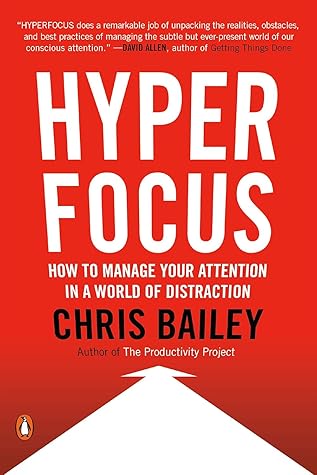More on this book
Community
Kindle Notes & Highlights
by
Chris Bailey
Read between
August 13 - August 20, 2022
When it comes to your most important tasks, the fewer things you pay attention to, the more productive you become.
The most important aspect of hyperfocus is that only one productive or meaningful task consumes your attentional space.
Because habits consume so little of our attentional space, there’s really no need to hyperfocus on them.
Studies analyzing skilled typists found this same phenomenon: the more attention they brought to their typing, the slower they typed and the more mistakes they made. When doing such habitual tasks, it’s best to not focus completely on what you’re doing.
Save hyperfocus for your most complex tasks—things that will actually benefit from your complete attention, such as writing a report, mapping your team’s budget, or having a meaningful conversation with a loved one.
One of the best ways to get more done—and done faster—is by preventing yourself from focusing on things that aren’t important.
This first step to reaching hyperfocus mode is essential—intention absolutely has to precede attention.
Email alerts that pop into the corner of our screen are usually more tempting than the task we’re doing in another window; the TV behind our partner at the pub is usually more enticing than focusing on the conversation.
Distractions are infinitely easier to deal with in advance—by the time they appear, it’s often already too late to defend our intention against them.
Third, hyperfocus becomes possible when we focus on our chosen object of attention for a predetermined amount of time.
Fourth, and finally, hyperfocus is about drawing our attention back to the original object of attention when our mind wanders.
research shows that our mind wanders for 47 percent of the day.
normal for our mind to wander, but the key is to center it so we can spend time and attention on what’s actually in front of us.
In addition, it takes an average of twenty-two minutes to resume working on a task after we’re distracted or interrupted.
The more often we assess what’s occupying our attentional space, the quicker we’re able to get back on track.
the start of each day, choose the three things you want to have accomplished by day’s end.
By forcing yourself to pick just three main intentions at the start of each day, you accomplish several things.
This is a powerful idea to internalize, especially since the most important tasks are often not the ones that immediately feel the most urgent or productive.


